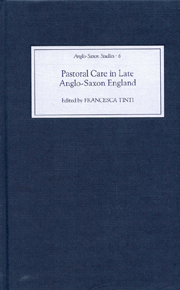Book contents
- Frontmatter
- Contents
- List of illustrations
- List of contributors
- Abbreviations
- Introduction
- 1 The clergy in English dioceses c. 900–c. 1066
- 2 The ‘costs’ of pastoral care: church dues in late Anglo-Saxon England
- 3 Ælfric in Dorset and the landscape of pastoral care
- 4 Is there any evidence for the liturgy of parish churches in late Anglo-Saxon England? The Red Book of Darley and the status of Old English
- 5 Remedies for ‘great transgressions’: penance and excommunication in late Anglo-Saxon England
- 6 The pastoral contract in late Anglo-Saxon England: priest and parishioner in Oxford, Bodleian Library, MS Laud Miscellaneous 482
- 7 Caring for the dead in late Anglo-Saxon England
- Index
4 - Is there any evidence for the liturgy of parish churches in late Anglo-Saxon England? The Red Book of Darley and the status of Old English
Published online by Cambridge University Press: 12 September 2012
- Frontmatter
- Contents
- List of illustrations
- List of contributors
- Abbreviations
- Introduction
- 1 The clergy in English dioceses c. 900–c. 1066
- 2 The ‘costs’ of pastoral care: church dues in late Anglo-Saxon England
- 3 Ælfric in Dorset and the landscape of pastoral care
- 4 Is there any evidence for the liturgy of parish churches in late Anglo-Saxon England? The Red Book of Darley and the status of Old English
- 5 Remedies for ‘great transgressions’: penance and excommunication in late Anglo-Saxon England
- 6 The pastoral contract in late Anglo-Saxon England: priest and parishioner in Oxford, Bodleian Library, MS Laud Miscellaneous 482
- 7 Caring for the dead in late Anglo-Saxon England
- Index
Summary
O rustic priest, I suppose you do not know what an atom is.
In the mid eleventh century, a substantial proportion of the population of England would have had access to a local church. Such institutions varied greatly, encompassing both the faded glory of a once greatmother church which retained a small community of clerks, and the small chapel newly built by a local lord and served by a single priest. If the estimates of the number of churches built (or rebuilt) in the later tenth and eleventh centuries are anything like accurate, there must have been a lot of liturgy going on. What, for example, did the priest of the tiny single-cell church constructed in the tenth century immediately outside the manorial enclosure at Raunds, Northamptonshire actually do?
The written and architectural sources suggest there was a demand for priests in the eleventh century and that those who supported them, whether local lords or local people, would have expected something for their money. How did these priests learn their job? Did they have any kind of education and, if not, how did they cope with the Latin of the liturgy? Presumably most of them learnt by experience, as liturgy has long been taught, and the evidence for inheritance of churches by the children of priests suggests how this could happen. We will probably never know much about the rites they presided over.
- Type
- Chapter
- Information
- Pastoral Care in Late Anglo-Saxon England , pp. 63 - 82Publisher: Boydell & BrewerPrint publication year: 2005



